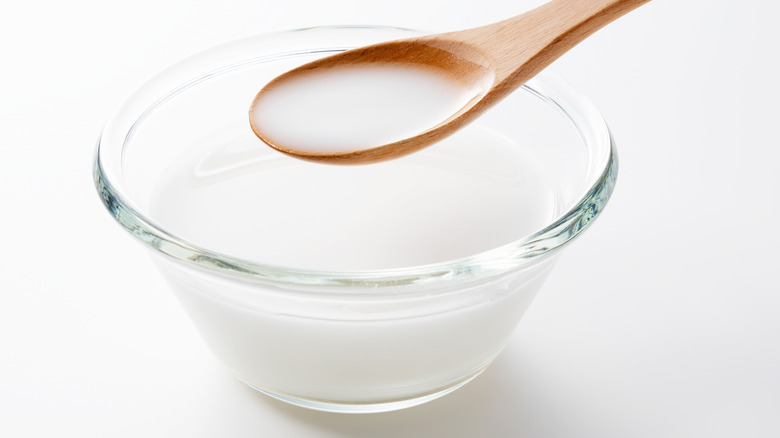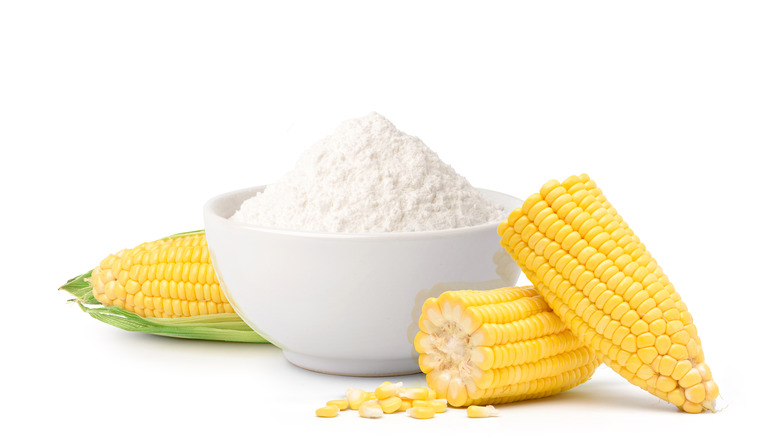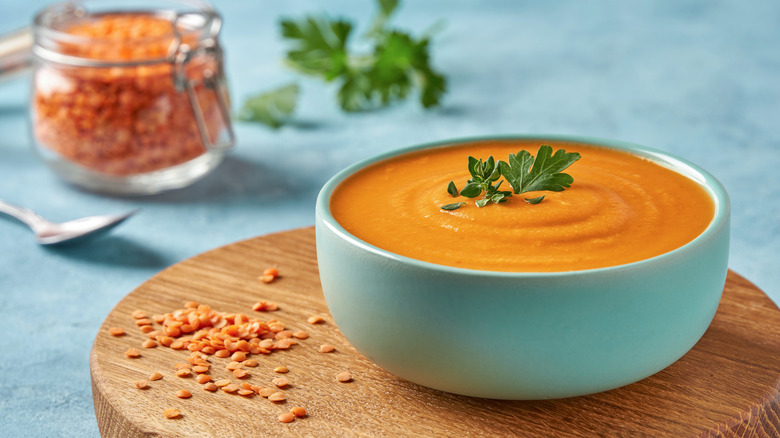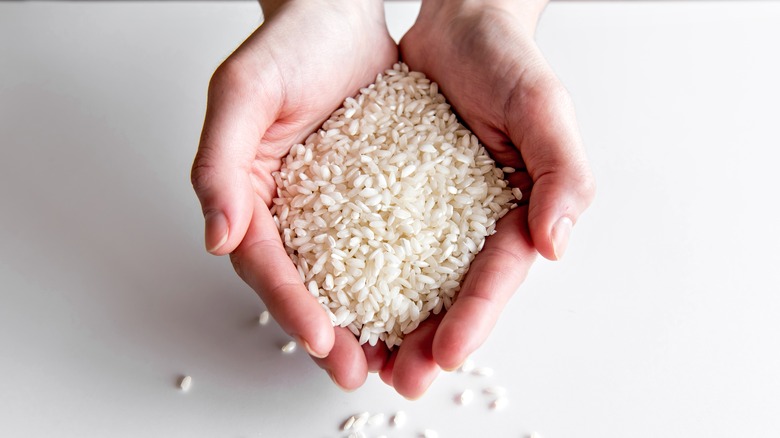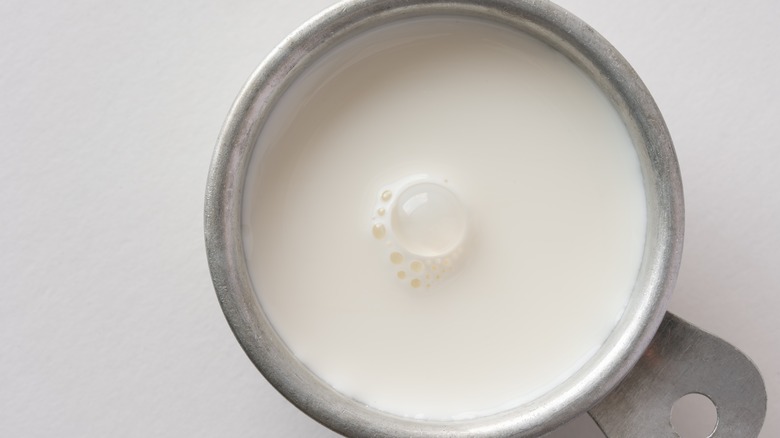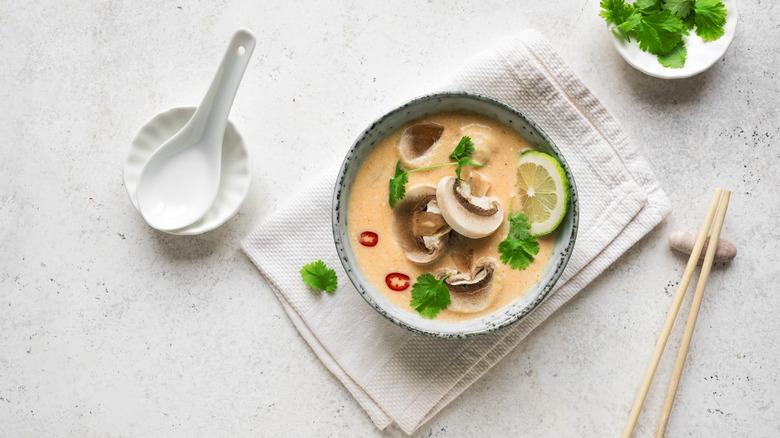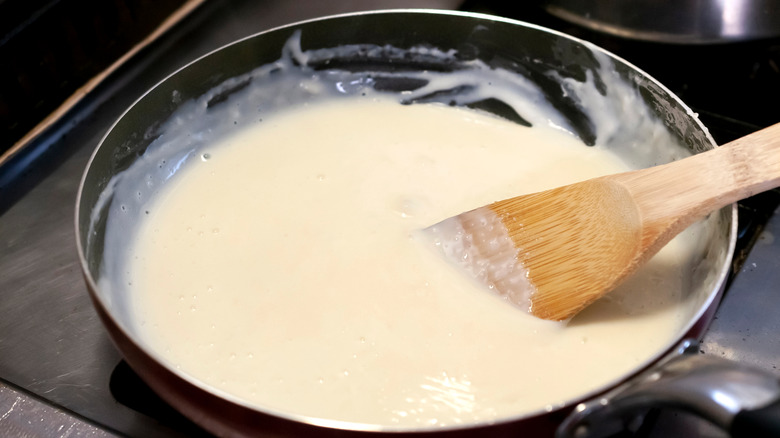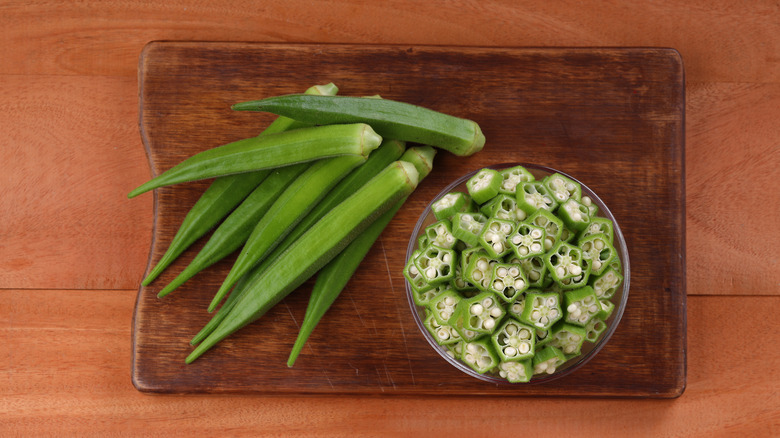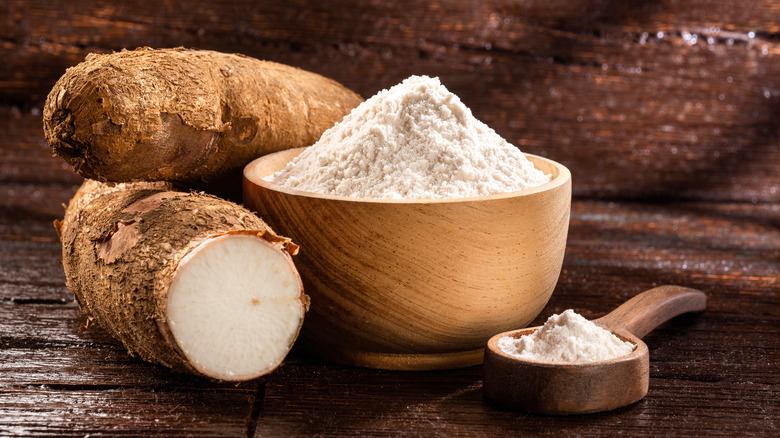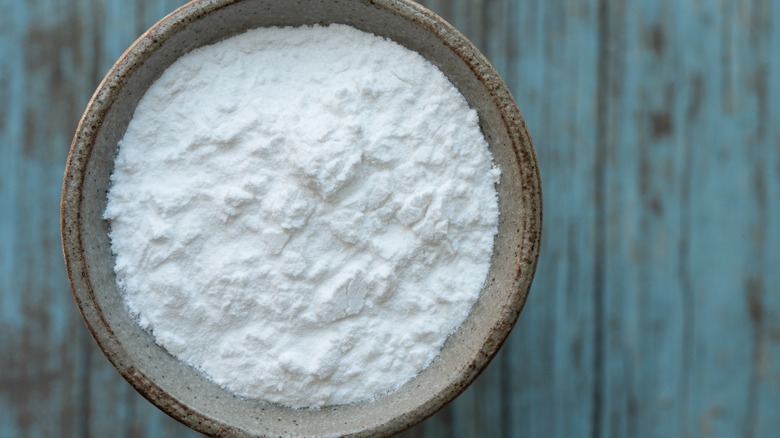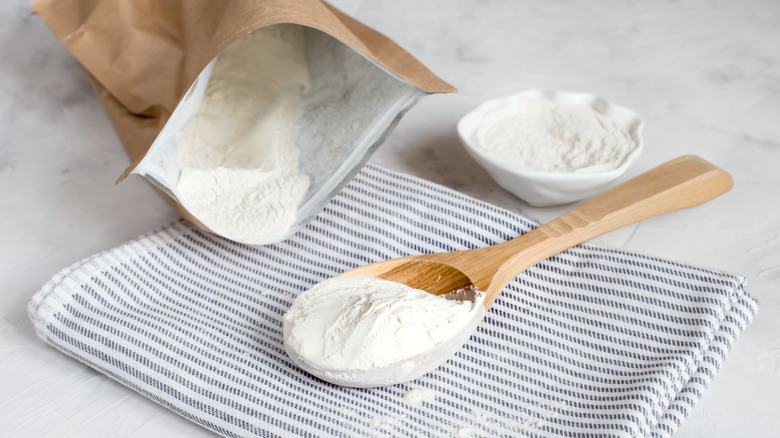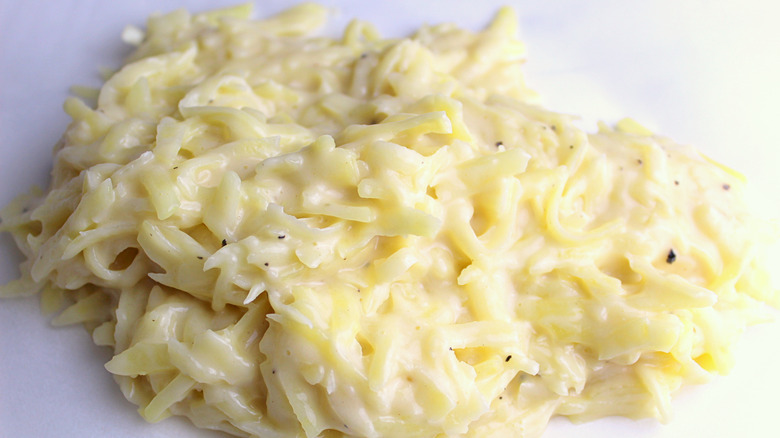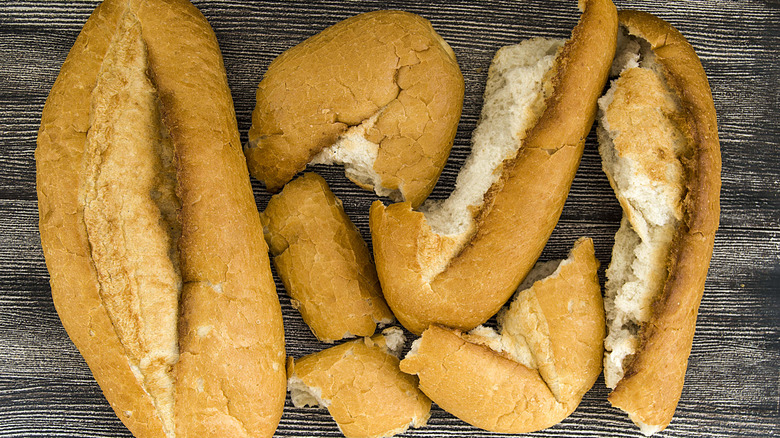The 15 Best Ingredients To Thicken Homemade Soup
In addition to being flavorful, the broth of a soup is supposed to tie together all the ingredients with the perfect viscosity. When soup broth has the ideal thickness, the texture keeps you coming back again and again. Sometimes, simply letting your soup cook down can lead to the consistency you want. There are other instances, however, when your soup needs a thickening agent.
Various soup thickeners have different qualities, and the type of soup you're making should dictate the thickener you use. Some ingredients create a translucent appearance that's great for chicken pho or noodle soup. Others add opaqueness that vibes well with roasted tomato soup. Some thickeners add deep flavors, while some are completely flavorless. For instance, if you're making tom kha gai, adding coconut milk makes more sense than cornstarch.
When adding a thickener, consider any dietary requirements of those who will eat it. Some of these ingredients are gluten-free or vegan, and others support a low-carb diet. Because just a teaspoon can make a big difference, it's a good idea to know which thickeners do what and when to use them. If all of this is boggling your mind, don't worry. We'll break down the best thickeners to use for any variety of soup you wish to make.
Add thickness with a flour slurry
One of the most common ways to thicken homemade soup is to incorporate some flour. If you have never done this before, it's essential to know that you shouldn't add flour directly to the hot liquid. Doing so often leads to clumps of flour floating in a soup, not a thicker consistency.
Instead, you should create a flour slurry. Add a small amount of flour — about 1/4 cup — to a bowl, then enough water or hot broth from your soup to create a slurry that easily runs down the wires of a whisk. Next, mix your slurry into the soup — about one tablespoon at a time — as you stir. Give each slurry addition about a minute to incorporate and thicken the soup. The idea is to gradually add flour until you reach your desired consistency. The mistake you need to avoid when thickening with flour is adding too much at once, as it could lead to lumps or a soup that is too thick.
Adding flour gives your soup the subtle flavor of flour and causes it to become opaque. This effect is most desirable in thick and cream-based soups with strong flavors.
Cornstarch should be your thickener of choice
Not to be confused with the much coarser cornmeal, cornstarch is a fine white powder made by heavily processing corn to extract carbohydrates. It was created in 1842 by Thomas Kingsford, a former worker in a New Jersey wheat starch factory (via Argo). At first, cornstarch was used to press laundry, and it is still used for this today.
Although cornstarch has little taste or nutritional value, it can work wonders in the kitchen. Some people prefer to use cornstarch as a thickener over flour because it has double the thickening power. As with flour, cornstarch should be added to soup as slurry. Once the cornstarch is added to hot soup, however, the comparisons stop. As granules of cornstarch increase in temperature, they begin to absorb water and swell — eventually busting open. The starch molecules that are released create a gelatinous network. At 194 F, cornstarch suspended in water becomes completely gelatinous, according to research from the University of Nebraska.
As with any thickener, you should add cornstarch slurry a little bit at a time and wait a couple of minutes for it to fully incorporate. If you add too much, you'll have a slimy texture and even get a bit of unwanted flavor from the cornstarch.
Red beans or lentils can thicken a pureed soup
When lentils are cooked down into a thick consistency, they form the basis for the iconic Indian soup called dal. Likewise, when red beans are cooked until tender and mashed, they create a thick consistency that gives any red beans and rice recipe its signature texture. But you don't need to cook Indian or Cajun food to use either of these legumes to thicken your soup. Adding cooked red lentils or beans to a soup not only thickens the dish, but these legumes also offer more than flour or cornstarch; either will contribute protein and a rich earthy flavor.
There are a few things you should consider when using this type of thickener. Both lentils and beans should be mashed or puréed before adding them to a soup. When looking for a velvety texture, you'll have to purée your cooked legumes for several minutes. If you're cooking lentils, you should also know that cooking red lentils changes their color to yellow. If you're trying to make a dark-colored soup, this can be an issue.
Bring the magic of risotto with arborio rice
The high starch content that makes arborio rice the best rice for risotto also makes it ideal for thickening soups. While it's okay to add a splash of heavy cream to your risotto, that smooth texture should come almost entirely from starches released by the rice.
If you are using arborio rice to thicken a soup, you should take a page out of your favorite risotto recipe and make sure you are constantly agitating the rice to release starches. Adding a handful of arborio rice a few minutes before serving your soup won't do much to thicken it up.
Alternatively, you could cook rice, purée it, and then add it to a rich or creamy soup. If you're going to purée the rice first, it helps if you cook the rice beyond al dente, ensuring that it has absorbed all of the water. When each grain of rice has absorbed as much as possible, it will purée more easily into a creamy texture.
Use pasta starch in a couple of different ways
You may have heard that adding starchy pasta water to pasta sauce helps to thicken up the sauce and "marry" the sauce to the pasta. Assuming you correctly salted your pasta water, adding it to pasta sauce infuses the sauce with flavor, seasoning, and starch. It's that critical last element that can be used to thicken up your soup.
When you cook pasta, it releases starch. If you have a watery sauce, you can put pasta directly into the sauce to thicken it. In fact, there are a number of one-pot pasta recipes that make use of this technique. This pasta cooking hack is one to keep in your back pocket and apply to thin soup. Simply adding boxed or fresh pasta to a soup will thicken it as the pasta cooks. Just be sure not to add your pasta too early if you want to maintain a bit of toothiness.
Alternatively, you could use leftover pasta water. Reducing it down over low heat will give you a more powerful thickener that you should use incrementally until you achieve your desired consistency.
Thicken soup with egg yolks and a bit of technique
Different cuisines have different ways of thickening soups. In Greek cooking, avgolemono is a lemony chicken soup that is thickened with eggs. Achieving the desired texture for this soup involves more than yanking a couple of eggs out of the refrigerator and cracking them into a pot of simmering liquid, basically something out of an egg drop soup recipe. Instead, the eggs should be whisked with a substantial amount of lemon juice to create a foam. Before it's added to the soup, the egg mixture is tempered by adding a ladle full of warm broth.
If you use eggs to thicken your soup, you're leveraging centuries of Mediterranean culinary knowledge. Avgolemono soup likely came to Greece with Sephardic Jews, who were expelled from Spain in 1492 (via Yad Vashem). In addition to avgolemono, Sephardic Jews also brought their religion and the Ladino language — a mixture of Spanish and Hebrew. The soup also uses lemons, which have flourished in Greece since the 5th century B.C.
Kill two birds with heavy cream or half-and-half
If you are making a cream-based soup, adding more cream is a simple way to thicken it. If you're in the middle of a recipe and don't have heavy cream, you could use half-and-half, as the two are largely interchangeable. The main difference between heavy cream and half-and-half is fat content. Heavy cream contains about 36% fat, while half-and-half contains 10.5% to 18% fat. The latter might be a better option if you are concerned about your soup becoming too fatty.
In addition to thickening a creamy soup, adding heavy cream or half-and-half can also cool off a soup that's gotten way too spicy. The hot chili peppers used to make soups spicy have an organic compound called capsaicin, which triggers pain receptors on your tongue. All dairy products contain a protein called casein that breaks down casein. Because heavy cream or half-and-half will have a dual effect on spicy soups, it's best to add them slowly until it reaches your desired consistency and spice level.
Coconut milk should be used smartly
Coconut milk is a central ingredient in soups like tom kar gai and one-pot Thai coconut soup. Typically, recipes call for full-fat coconut milk as opposed to the light variety. Although light coconut milk could be considered healthier, it lacks the flavor and viscosity of the full-fat variety. As such, light coconut milk isn't a very good thickener compared to full-fat coconut milk, just as skim milk isn't a great soup thickener compared to heavy cream.
Another tip for using coconut milk is to shake the can before using it. A can of coconut milk only needs to sit around for a day or two before it separates into two layers: the top layer of thick coconut cream and the bottom layer of coconut water. Shaking the can before you open it helps emulsify your coconut milk so you can slowly add it to thicken your soup.
If your soup is dairy-based, you can still use coconut milk as a thickener. However, coconut milk has a signature taste and is often sweeter than whole milk or heavy cream. If you only use a little bit to thicken your soup, these unique qualities may not be a concern. It is a good idea to consider how coconut milk might interact with the flavors already commingling into your soup.
Add depth of flavor and thicken with roux
Made of flour sautéed in fat, roux is a staple of classic French cooking that has been used as a thickener for hundreds of years (via Auguste Escoffier School of Culinary Arts). Before making a roux, you should know there are four different kinds, with each one based on how long the flour is cooked. The type of roux to use depends on the flavor intensity of your soup.
White roux is finished in two or three minutes, cooked just long enough to eliminate the taste of raw flour. Blonde roux has a slightly nutty flavor that is developed after five to 10 minutes of cooking under low to medium heat. Brown roux has a deep nutty flavor that takes 25 to 30 minutes to develop. Dark brown roux has deep intense flavors that develop after 40 minutes and are often used in Cajun cooking.
The roux at the iconic Dooky Chase Restaurant in New Orleans is the stuff of legends, as is its chef Leah Chase. If you're making a lighter roux, it's okay to use butter as your fat. However, if you're making roux to thicken a darker soup, like gumbo, Chase recommends a neutral oil like canola oil. The NOLA legend also recommends using a cast iron or another heavy-bottomed pan that distributes heat evenly. Roux can be safely refrigerated for weeks. Make it ahead, and you'll have a flavorful thickener whenever you need it!
Use okra to thicken with a Cajun-Creole twist
Brought to the Americas from Africa via the transatlantic slave trade, okra is known for containing a slimy mucus made of sugar residues and proteins (via Food Republic). Okra's slime makes it a bit divisive. But one person's trash is another person's treasure, as they say. The slime that some find repulsive is essential to thickening okra gumbo.
Okra has a subtle taste that some have compared to green beans. If you're going to use it as a thickener, you should brown it to create additional flavor. Chop okra pods into thick coins and sauté the coins in vegetable oil over medium heat. Stir frequently to keep the okra from burning, and cook it until slightly brown. The longer you cook it, the more you'll cook out the slime, so be judicious when your main goal is to use it as a thickener. In addition to giving your soup the consistency you want, okra brings lots of vitamins and antioxidants, according to Healthline.
Make soup silkier with tapioca
You might not be familiar with tapioca starch as an ingredient, but you have probably eaten it. In addition to being the key ingredient in tapioca pudding, it's also used to form the balls in your favorite flavors of boba tea.
Made from the cassava root, tapioca doesn't really taste like anything, but as an effective thickener, it acts as a blank canvas for other flavors. Just as with other powdery thickeners, it should be mixed with water and made into a slurry before it's added to your soup. Once tapioca is heated and hydrated, it lends a silky texture and shiny, translucent appearance — both of which are somewhat reminiscent of using cornstarch. Unlike cornstarch, tapioca can become stringy when it nears the boiling point of water. Tapioca is a great gluten-free alternative to flour and can be used as a one-for-one swap.
If you have a container of tapioca sitting in your pantry and want to use it for more than just thickening soup, you should know that it's commonly used to make gluten-free bread, including pizza crusts and pastries. When used in baking, tapioca starch lends a chewy texture and helps to retain moisture.
Arrowroot is an underappreciated alternative thickener
Called arrowroot powder, arrowroot flower, and arrowroot starch, this thickener is made by processing the tropical arrowroot tuber (via Bob's Red Mill). Like other thickeners, arrowroot is mostly odorless and flavorless. It's also a gluten-free alternative to flour. Arrowroot is an excellent substitute for cornstarch in acidic soups and sauces because acid won't break it down, unlike cornstarch, according to food scientist Jessica Gavin. When buying arrowroot, look for packages that only list arrowroot as the main ingredient, and you will avoid unnecessary fillers and additives, such as potato starch.
As with other powdery thickeners, arrowroot should be incorporated into soup as a slurry to prevent clumping. Gavin recommends a two-to-one ratio of arrowroot to water to create your slurry. The slurry should be added at the end of the cooking process to water between 185 F and 206 F. If the soup becomes too hot, the arrowroot will start to clump and become unusable. Gavin also says arrowroot does not retain thickening power as long as regular flour or cornstarch. If your soup is reheated, it may become thinner.
Stay gluten-free with gum powders
In days of old, you may have seen an ingredient like xanthan gum listed on a package and thought it is some type of chemical that you should really be avoiding. But lately, there's been an increased interest in bringing science to the kitchen, and as a result, thickeners like xanthan gum and guar gum are seen in a very different light.
Developed in the 1950s by chemist Allene Rosaline Jeanes (via USDA), xanthan gum is produced from the bacteria Xanthomonas campestris. The bacteria produce a protective coating that is extremely sticky, and xanthan gum is made by harvesting this coating (via Bob's Red Mill). This gluten-free thickener should be incorporated into a soup as a slurry and little by little. Be sure to store xanthan gum in an airtight container.
Guar gum is a similar thickener that you could use to thicken soup. The main difference between xanthan gum and guar gum is the fact that guar gum requires the use of borax or calcium to become gelatinous. Made the guar beans, guar gum is also priced much lower than xanthan gum.
Use potatoes as a pro-tip thickener
Potatoes might seem like a surprising ingredient you can use thicken soup, but the practice is somewhat common in the restaurant industry. In fact, it's common for restaurants to use leftover mashed potatoes as a soup thickener.
If you don't have day-old mashed potatoes sitting in your refrigerator, frozen hash browns will also do the trick. Like mashed potatoes, frozen hash browns are already cooked and will dissolve into potato starch over time if they are placed into a pot of hot soup.
If you are going to use frozen hash browns or mashed potatoes as a thickener, be sure to give the potatoes enough time to completely dissolve. Otherwise, you'll have lumps and bits of potato floating around. Although this approach takes a bit more effort than thickeners like cornstarch or flour, potatoes will bring a bit more flavor than those other ingredients. On top of that, cooked potatoes are also gluten-free (via Love Potatoes).
Make use of old bread
One of the best ways to use stale bread is as a soup thickener. It might sound a bit odd, but using old stale bread as a soup thickener is somewhat common in Mediterranean cooking. For a subtle thickening effect, turn the stale bread into breadcrumbs and stir in breadcrumbs a little bit at a time until you reach the desired consistency. If you're looking for a more dramatic and transformative effect, rip the stale bread into chunks and toss it into the soup. Just know that if you go this route, you're running the risk of making bread a defining quality of your soup, like the classic Italian bread soup ribollita.
Of course, there are also a number of other great uses for old stale bread, including French toast, stuffing, and bread pudding. Just be sure to check your bread for mold before proceeding with any of these uses.

